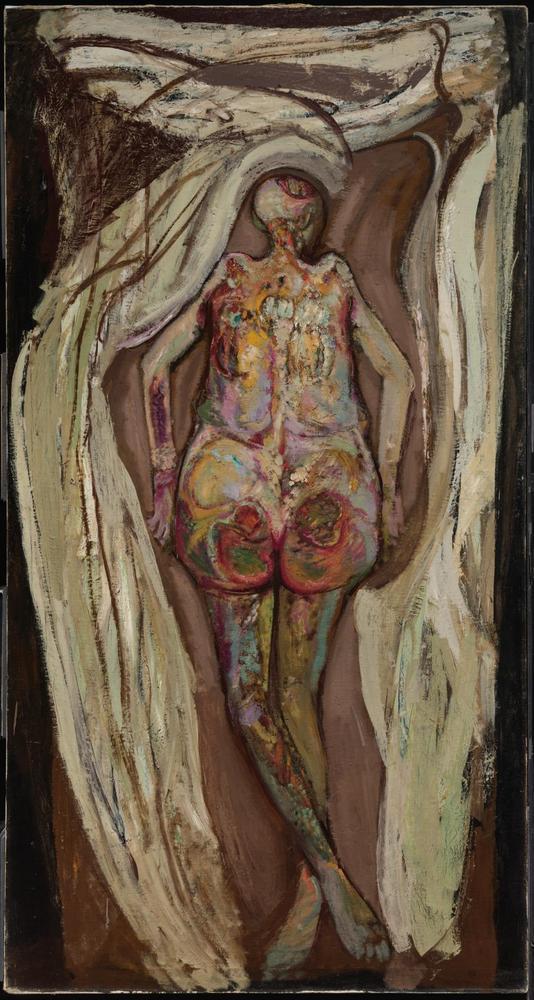Advanced Search
Female Corpse, Back View
Hyman Bloom (American, (born in Lithuania, now Latvia) 1913–2009)
1947
Medium/Technique
Oil on canvas
Dimensions
173.7 x 92.4cm (68 3/8 x 36 3/8in.)
Credit Line
Gift of William H. and Saundra B. Lane and Museum purchase
Accession Number1990.370
CollectionsAmericas
ClassificationsPaintings
In 1943 Bloom accompanied his friend and fellow painter David Aronson [2006.1257] to Kenmore Hospital in Boston to sketch cadavers. Aronson, who was working on a composition of the Resurrection of Christ, had wanted to see a corpse firsthand. Bloom’s response to the experience was twofold: “On the one hand it was harrowing, on the other it was beautiful—iridescent and pearly. It opened up avenues for feelings not yet gelled. It had a liberating effect. I felt something inside that I could express through color. As a subject it would synthesize things for me. The paradox of the harrowing and the beautiful could be brought into unity.” [1] From this visit, Bloom made a series of drawings that would lead him to paint three full-length cadaver images, all shown in a compressed, undefined space. Female Corpse, Back View, is the final composition in the series and the only one to depict the dead body from behind. [2] Fascinated with the changing colors of decomposing flesh, Bloom painted the unsettling subject with a beautiful, luminescent palette and thick impasto. His studies of philosophy, mysticism, and the occult, along with his belief in reincarnation, led him to see death not as an end, but as a celebratory part of the continuing cycle of life.
Bloom’s exploration of themes of death began early in his career and he drew on multiple sources for his work. For example, at Harvard University’s Germanic Museum (now the Busch-Reisinger Museum) he had found an image of the Entombment of Christ (after Hans Holbein) especially compelling, and its composition influenced a series of paintings of skeletons Bloom did in the mid-1930s. At around the same time, the carcass pictures of Chaim Soutine began to inform Bloom’s developing expressive approach to painting similar motifs of dead animals, which he continued to make well into the 1950s.
Female Corpse, Back View was included in the 1950 Virginia Museum of Fine Arts biennial exhibition, where it was roundly criticized in the local press as “a tongue-in-cheek pretense of ‘erudition’ which must be seen to be properly deprecated.” The critic for Art News, Alfred M. Frankfurter, defended it as “an important American picture . . . it violates the sacred bourgeois tabu that the cadaver is never brought into the parlor except for the actual funeral party . . . its fate will be to remain misunderstood until the metaphor is discovered beneath the superficial reality. [3] That the painting continues to elicit such polar responses today is a testament to the power of Bloom’s work.
Notes
1. Lois Tarlow, “Alternative Space: Hyman Bloom,” Art New England 4, no. 4 (March 1983): 15.
2. The other paintings in the series are Corpse of Man (1944, Rose Art Museum, Brandeis University, Waltham, Massachusetts) and Female Corpse, Front View (1945, Jewish Museum, New York).
3. Both quotes in Alfred M. Frankfurter, “Vernissage,” Art News 49 (May 1950): 17.
Karen E. Quinn
Bloom’s exploration of themes of death began early in his career and he drew on multiple sources for his work. For example, at Harvard University’s Germanic Museum (now the Busch-Reisinger Museum) he had found an image of the Entombment of Christ (after Hans Holbein) especially compelling, and its composition influenced a series of paintings of skeletons Bloom did in the mid-1930s. At around the same time, the carcass pictures of Chaim Soutine began to inform Bloom’s developing expressive approach to painting similar motifs of dead animals, which he continued to make well into the 1950s.
Female Corpse, Back View was included in the 1950 Virginia Museum of Fine Arts biennial exhibition, where it was roundly criticized in the local press as “a tongue-in-cheek pretense of ‘erudition’ which must be seen to be properly deprecated.” The critic for Art News, Alfred M. Frankfurter, defended it as “an important American picture . . . it violates the sacred bourgeois tabu that the cadaver is never brought into the parlor except for the actual funeral party . . . its fate will be to remain misunderstood until the metaphor is discovered beneath the superficial reality. [3] That the painting continues to elicit such polar responses today is a testament to the power of Bloom’s work.
Notes
1. Lois Tarlow, “Alternative Space: Hyman Bloom,” Art New England 4, no. 4 (March 1983): 15.
2. The other paintings in the series are Corpse of Man (1944, Rose Art Museum, Brandeis University, Waltham, Massachusetts) and Female Corpse, Front View (1945, Jewish Museum, New York).
3. Both quotes in Alfred M. Frankfurter, “Vernissage,” Art News 49 (May 1950): 17.
Karen E. Quinn
ProvenanceBy 1958, Durlacher Brothers Gallery, New York; 1958, sold by the Durlacher Brothers Gallery to William H. Lane (b. 1914 - d. 1995), Lunenburg, MA; 1990, partial sale and partial gift of William H. and Saundra B. Lane to the MFA. (Accession Date: June 27, 1990)
CopyrightReproduced with permission.



